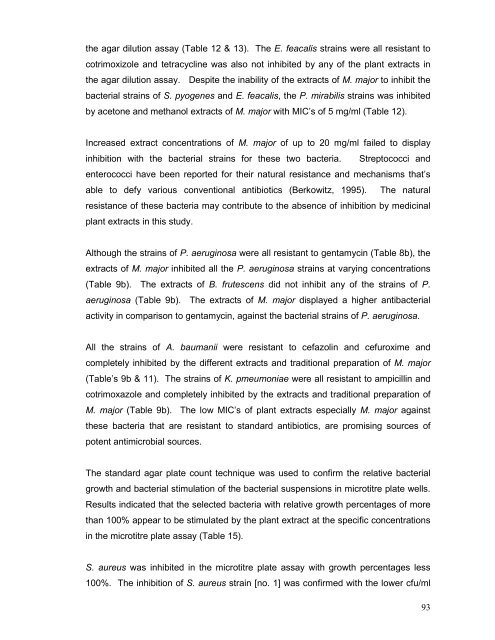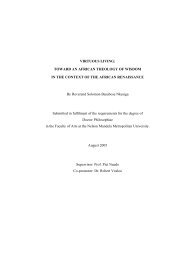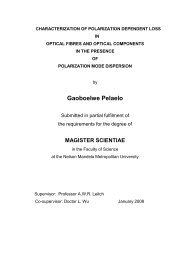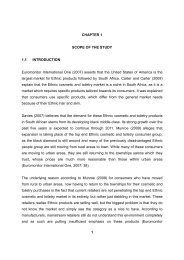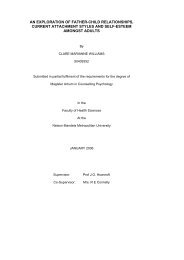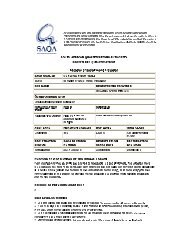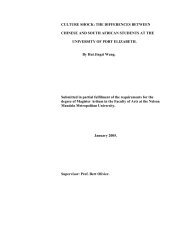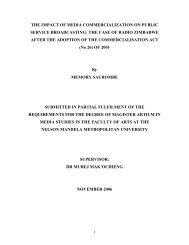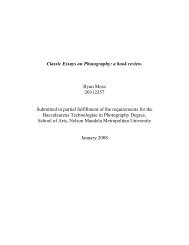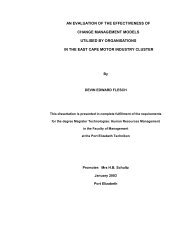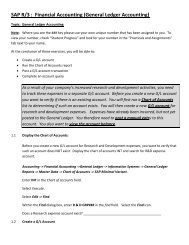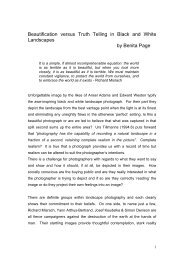an investigation into the antibacterial activities of medicinal plants ...
an investigation into the antibacterial activities of medicinal plants ...
an investigation into the antibacterial activities of medicinal plants ...
You also want an ePaper? Increase the reach of your titles
YUMPU automatically turns print PDFs into web optimized ePapers that Google loves.
<strong>the</strong> agar dilution assay (Table 12 & 13). The E. feacalis strains were all resist<strong>an</strong>t to<br />
cotrimoxizole <strong>an</strong>d tetracycline was also not inhibited by <strong>an</strong>y <strong>of</strong> <strong>the</strong> pl<strong>an</strong>t extracts in<br />
<strong>the</strong> agar dilution assay. Despite <strong>the</strong> inability <strong>of</strong> <strong>the</strong> extracts <strong>of</strong> M. major to inhibit <strong>the</strong><br />
bacterial strains <strong>of</strong> S. pyogenes <strong>an</strong>d E. feacalis, <strong>the</strong> P. mirabilis strains was inhibited<br />
by acetone <strong>an</strong>d meth<strong>an</strong>ol extracts <strong>of</strong> M. major with MIC’s <strong>of</strong> 5 mg/ml (Table 12).<br />
Increased extract concentrations <strong>of</strong> M. major <strong>of</strong> up to 20 mg/ml failed to display<br />
inhibition with <strong>the</strong> bacterial strains for <strong>the</strong>se two bacteria. Streptococci <strong>an</strong>d<br />
enterococci have been reported for <strong>the</strong>ir natural resist<strong>an</strong>ce <strong>an</strong>d mech<strong>an</strong>isms that’s<br />
able to defy various conventional <strong>an</strong>tibiotics (Berkowitz, 1995). The natural<br />
resist<strong>an</strong>ce <strong>of</strong> <strong>the</strong>se bacteria may contribute to <strong>the</strong> absence <strong>of</strong> inhibition by <strong>medicinal</strong><br />
pl<strong>an</strong>t extracts in this study.<br />
Although <strong>the</strong> strains <strong>of</strong> P. aeruginosa were all resist<strong>an</strong>t to gentamycin (Table 8b), <strong>the</strong><br />
extracts <strong>of</strong> M. major inhibited all <strong>the</strong> P. aeruginosa strains at varying concentrations<br />
(Table 9b). The extracts <strong>of</strong> B. frutescens did not inhibit <strong>an</strong>y <strong>of</strong> <strong>the</strong> strains <strong>of</strong> P.<br />
aeruginosa (Table 9b). The extracts <strong>of</strong> M. major displayed a higher <strong>an</strong>tibacterial<br />
activity in comparison to gentamycin, against <strong>the</strong> bacterial strains <strong>of</strong> P. aeruginosa.<br />
All <strong>the</strong> strains <strong>of</strong> A. baum<strong>an</strong>ii were resist<strong>an</strong>t to cefazolin <strong>an</strong>d cefuroxime <strong>an</strong>d<br />
completely inhibited by <strong>the</strong> different extracts <strong>an</strong>d traditional preparation <strong>of</strong> M. major<br />
(Table’s 9b & 11). The strains <strong>of</strong> K. pmeumoniae were all resist<strong>an</strong>t to ampicillin <strong>an</strong>d<br />
cotrimoxazole <strong>an</strong>d completely inhibited by <strong>the</strong> extracts <strong>an</strong>d traditional preparation <strong>of</strong><br />
M. major (Table 9b). The low MIC’s <strong>of</strong> pl<strong>an</strong>t extracts especially M. major against<br />
<strong>the</strong>se bacteria that are resist<strong>an</strong>t to st<strong>an</strong>dard <strong>an</strong>tibiotics, are promising sources <strong>of</strong><br />
potent <strong>an</strong>timicrobial sources.<br />
The st<strong>an</strong>dard agar plate count technique was used to confirm <strong>the</strong> relative bacterial<br />
growth <strong>an</strong>d bacterial stimulation <strong>of</strong> <strong>the</strong> bacterial suspensions in microtitre plate wells.<br />
Results indicated that <strong>the</strong> selected bacteria with relative growth percentages <strong>of</strong> more<br />
th<strong>an</strong> 100% appear to be stimulated by <strong>the</strong> pl<strong>an</strong>t extract at <strong>the</strong> specific concentrations<br />
in <strong>the</strong> microtitre plate assay (Table 15).<br />
S. aureus was inhibited in <strong>the</strong> microtitre plate assay with growth percentages less<br />
100%. The inhibition <strong>of</strong> S. aureus strain [no. 1] was confirmed with <strong>the</strong> lower cfu/ml<br />
93


